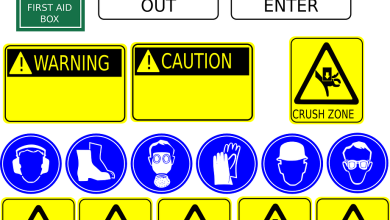Personal Protective Equipment (PPE) and Its Importance in Workplace Safety

It is imperative that health and safety be given top attention in every job. Not only is the health and welfare of the employees themselves important, but also the well-being of the employees is essential to the efficient operation of the company. The proper application of personal protective equipment (also known as PPE) is an essential component of occupational safety. Personal protective equipment, or PPE, is extremely important in the prevention of injuries, illnesses, and even fatalities among employees by shielding them from the numerous hazards that are prevalent in their working environments. This article examines the significance of personal protective equipment (PPE) in terms of ensuring the continued safety of the workplace, as well as focuses on the various forms and functions of PPE.
Recognizing the Importance of Personal Protective Equipment (PPE)
The term “Personal Protective Equipment,” or PPE for short, refers to specialized gear that is designed to protect employees from potential hazards and reduce the risk of damage or disease. PPE is also widely abbreviated as “PPE.” The worker is protected from the dangerous materials that are present in their surroundings by personal protective equipment (PPE). It encompasses a vast variety of equipment, including but not limited to helmets, gloves, goggles, masks, respirators, earplugs, safety footwear, high-visibility apparel, and more. The nature of the work and the potential dangers involved should guide the selection of appropriate personal protective equipment (PPE).
The Importance of Personal Protective Equipment in the Workplace
PPE acts as a physical barrier against many hazards that can be found in the workplace, such as falling objects, chemical splashes, extreme temperatures, sharp objects, and airborne pollutants. This helps prevent injuries and illnesses that can occur in the workplace. Workers are able to greatly lower the risk of injuries, burns, respiratory problems, and other health issues related to their work environment if they wear the appropriate personal protective equipment (PPE).
Compliance with Regulations about Occupational Health and Safety Strict regulations about occupational health and safety have been developed by governments and regulatory agencies all over the world. Employers have a legal need to create a safe working environment for their employees, and part of this obligation involves providing the proper personal protective equipment (PPE). The firm will not only be in accordance with the law if it follows these standards but doing so will also protect its employees.
Providing sufficient personal protective equipment (PPE) to employees displays a commitment to their well-being, which helps to promote a pleasant work environment. This contributes to an increase in employee confidence and morale. When workers have the impression that they are safe and protected, it boosts their morale and confidence, which in turn leads to better production and a higher level of job satisfaction. Moreover, making an investment in personal protective equipment demonstrates that a firm appreciates its workforce and places a high priority on the protection of its workers.
Reducing the Impact of Financial Losses Accidents and injuries that occur on the job can have a significant negative impact on both the finances of employees and businesses. Personal protective equipment (PPE) is a vital precaution that can be taken to reduce the possibility of accidents and the accompanying costs, which can include legal fees, medical bills, claims for workers’ compensation, and lost production time due to staff absences. Organizations have the ability to reduce the severity of these financial losses and keep their bottom lines healthy if they make investments in PPE.
Different Personal Protective Equipment and How to Use It
Helmets offer protection against a variety of head injuries, including those that can be caused by falling items, electrical hazards, and impacts or accidents. They find widespread application in the realms of construction, manufacturing, and other industrial contexts.
Eye and facial Protection: Eye and facial protection are provided by safety goggles and face shields, which protect against harmful substances, flying debris, sparks, and harsh light. Eye and face protection is essential in industries such as construction, welding, and chemical handling because it helps reduce the likelihood of burns and injuries to the face and eyes.
Protection for the Hands and Arms Gloves, gauntlets, and sleeves offer defense against heat dangers, chemical contact, and punctures in addition to providing protection against abrasions and cuts. They find widespread application in the fields of medicine, building, and research and development, respectively.
Respiratory Protection: Respirators, dust masks, and air-purifying equipment protect workers from hazardous airborne chemicals such as dust, fumes, gases, and biological pollutants. This type of protection is also known as respiratory protection. Respiratory protection is used in a variety of professions, including mining, painting, and healthcare, to reduce the risk of respiratory infections and long-term damage.
Hearing protection includes earplugs, earmuffs, and other devices that shield employees from dangerously high noise levels, thereby reducing the risk of hearing loss and other auditory issues. Hearing protection is essential for ensuring the workers’ auditory health in fields that are subjected to high levels of noise, such as the construction, manufacturing, and aviation industries.
Foot & Leg Protection Protect your feet and legs from hazards such as falling objects, crushing hazards, punctures, and electrical shocks with safety shoes, boots, and leggings. In fields such as construction, manufacturing, and logistics — all of which have a high incidence of foot and leg injuries — they are an absolute necessity.
Conclusion
The use of personal protective equipment, also known as PPE, is critical to the continued safety of the workplace and the avoidance of injuries, diseases, and even fatalities. By demonstrating their dedication to the health and safety of their workforce, complying with legislation governing occupational health and safety, boosting employee morale, and mitigating financial losses, companies can demonstrate their commitment to the provision of suitable PPE to their employees. When it comes to choosing the appropriate personal protective equipment (PPE) for a given set of workplace dangers, having a solid understanding of the many kinds of PPE and the tasks they perform is essential. The use of personal protective equipment (PPE) should be prioritized not just to safeguard workers but also because it contributes to a workplace environment that is more productive, efficient, and harmonious. When it comes to the safety of the workplace, personal protective equipment is not simply a need; it is also a potential lifesaver.





